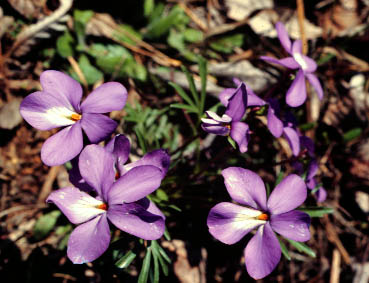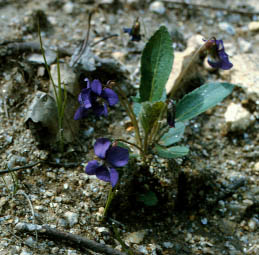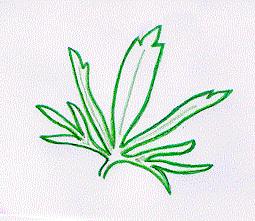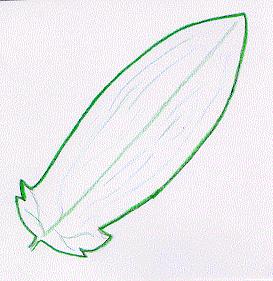Genus Viola
The Violets
web page constructed by Melissa
Bugbee
July 12, 1998

 Viola pedata
Viola sagittata
Photo
by W. H. Duncan
Photo by W.H. Duncan
courtesy of UGA Herbarium
courtesy of UGAHerbarium
Viola pedata
Viola sagittata
Photo
by W. H. Duncan
Photo by W.H. Duncan
courtesy of UGA Herbarium
courtesy of UGAHerbarium
link to V.
pedata
link to V.
sagittata
Contents:
Higher Taxa:
The classification of the genus Viola is as follows
(Zomlefer, 1994):
Class Angiosperma
Subclass Dicotyledonae
Superorder Violanae
Order Violales
Family Violaceae
Genus Viola
Description of Viola:
The genus Viola is one of 22 genera
in the family Violaceae, which contains over 900 species. Hybanthus
is the next most common genus in North America and includes the green violet.
Radford et.al. (p.234) gives the following
key for distinguishing between these two genera.
"-Petals green; calyx about equaling corolla;
fruit 1.5-2 cm long; seed 3 mm or more long............Hybanthus
-Petals not green; calyx not more
than 1/2 a long as corolla, or more and corolla greatly exceeding
10 mm; fruit 1.3 cm or less long; seed less than 3 mm long..........................................................................................Viola."
The numerous species (~500)
in Viola are commonly known as the violets and are usually easy
to recognize by their distinctively shaped leaves and flowers. The
flowers have five sepals and five petals, with one lowered and scoop-like.
The anthers of the five stamens cluster around the base of the pistil,
which is solitary and has a club-like style and stigma (Grimm,
p.173).
Species List:
The genus Viola contains around 500 species worldwide,
with 87 occurring in North America (Zomlefer, 1994).
The following list contains 45 species that occur in the southeastern United
States, as compiled by Radford, Ahles, and Bell in Guide
to the Vascular Flora of the Carolinas, 1964. The common
names listed are as given by William Grimm in Recognizing
Flowering Wild Plants, 1968.
V. affinis
V. arvensis
V. blanda, Sweet White Violet
V. brittoniana, Coast Violet
V. canadensis, Canada
Violet
V. chalcosperma
V. conspersa, American
Dog Violet
V. cucullata, Marsh
Blue Violet
V. emarginata, Triangle
Leaf Violet
V. eriocarpa
V. esculenta
V. fimbriatula, Ovate
Leaf Violet
V. floridana
V. hastata, Halberd
Leaf Violet
V. hirsutula
V. incognita, Large
Leaf White Violet
V. kitaibeliana
V. lanceolata, Lance
Leaf Violet
V. langloisii
V. lovelliana
V. macloskevi, Northern
White Violet
V. pallens
V. palmata, Early
Blue Violet
V. papilionacea,
Common Blue Violet
V. pectinata
V. pedata, Bird's Foot Violet
V. pensylvanica,
Smooth Yellow Violet
V. priceana
V. primulifolia,
Primrose-Leaf Violet
V. pubescens,
Downy Yellow Violet
V. rafinesquii, Field Pansy
V. rostrata, Long-Spurred
Violet
V. rotundifolia,
Round Leaf Yellow Violet
V. rugulosa
V. sagittata, Arrow Leaf Violet
V. septemloba, Southern
Coast Violet
V. sororia, Woolly
Blue Violet
V. stoneana
V. striata, Striped
Violet
V. tricolor
V. triloba, Three-lobed
Violet
V. tripartita
V. villosa
V. vittata
V. walteri
Identification of Species:
Because the genus Viola contains 500 species,
many of which hybridize readily, identification of individual species can
be quite difficult. Radford et.al. (p. 234
- 236) gives a key for distinguishing between the species listed above.
The leaves of some violets make them easier to distinguish for the novice.
For example, V. pedata and V. sagittata, two species of the
so-called "acaulescent blue violets" have very distinctive leaves.
Pedata's leaves are divided into narrow segments and palmate, while
sagittata's leaves are shaped like arrows (see below). Experts
warn against using leaf blade characteristics as a classifying feature,
however, because the effects of hybridizations and environmental conditions
can lead to false identifications (McKinney p.5).


V. pedata leaf
V. sagittata leaf
drawing by M. Bugbee
drawing by M. Bugbee
General Information:
The violets have historical and economic importance
resulting from their beauty and from the compounds they contain.
Their cultivation in gardens (especially the Parma violets and the pansies)
dates back for centuries. Napoleon used them as a political
and romantic symbol, and they are prominent in literature and folklore.
The Romans and others much more recently have cited the medicinal qualities
of the violets. They are high in vitamin A, salicylic acid, and a
compound called violine, and have been used for headache relief, as laxatives
and diuretics, and as expectorants (Coon, 1977).
References:
-
Coon, Nelson. The Complete Book of Violets.
A.S. Barnes and Company, Inc.: New York, 1977. ISBN 0-498-02110-6
-
Dean, Blanche. Wildflowers of Alabama and Adjoining States.
University of Alabama Press: University, Alabama, 1973. ISBN 0-8173-0147-X
-
Duncan, Wilbur H. and John T. Kartesz. Vascular Flora of Georgia.
University of Georgia Press: Athens, GA, 1981. ISBN 0-8203-0538-3
-
Grimm, William. Recognizing Flowering Wild Plants.
Stackpole Books: Harrisburg, PN, 1968.
-
Jones, Samuel and Nancy Coile. The Distribution of the Vascular
Flora of Georgia. Department of Botany, University of Georgia,
Athens, GA.
-
Linn, Louis. Eastern North America's Wildflowers. A Sunrise Book:
New York, 1978. ISBN 0-87690-262-X
-
McKinney, Landon E. A Taxonomic Revision
of the Acaulescent Blue Violets (Viola) of North America. Botanical
Research Institute of Texas, Inc: Fort Worth, Texas, 1992. ISBN 0883-1475
-
Radford, Albert, Harry Ahles and C. Ritchie Bell.
Guide to the Vascular Flora of the Carolinas. University of
North Carolina Book Exchange: Chapel Hill, NC, 1964.
-
Stupka, Arthur. Wildflowers in Color.
Harper and Row Publishers: New York, 1965.
-
Zomlefer, Wendy B. Guide to Flowering Plant Families.
University of Chapel Hill Press: Chapel Hill, NC, 1994.
Links:
To visit the Time Life web page on violets, click
here.
Go Back To . . .
Melissa Bugbee
University of Georgia
Athens, GA
email: mbugbee@arches.uga.edu





